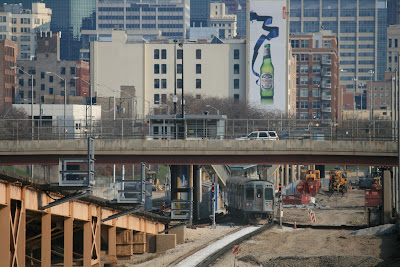The story so far...

The Government, finally realising that Britain is the laughing stock of Europe, sets up an "independent" company to survey and advise on the route for a new high speed railway line from London to the West Midlands, with a less detailed path onwards to Manchester and the North-West, and an outline of a possible route to Scotland. They had until the end of 2009.

Apparently the company has now submitted their report and, in the traditional open style for which British democracy is famed worldwide, the Government has decided it will be Top Secret until it decides it can be bothered to share it with us mere citizens. After all: they know what's best for us, eh?

So, inevitably, the leaks and the rumours start, and the juiciest one to emerge so far is that, rather than plug into one of London's numerous existing terminals, the report apparently proposes a completely new terminus.
_300dpi_1452846.jpg)
This is, as they say, a turn-up for the books.
While there is no obvious answer to where high speed trains should terminate, building a completely new terminus is fraught with difficulties. Let's run through what may have been the options:
 King's Cross
King's Cross. Er... no, it's full already. And while the upgrade of Thameslink may free up some space by allowing Great Northern outer suburban services to shuttle down to the basement, the platforms that would be freed up are (and this is almost laughable) far too short. Your average high speed train simply won't fit into the impossibly congested interiors of King's Cross.

Ok, what about
St Pancras, fresh from its £0.5bn makeover, and the home to Britain's only existing high speed trains, the Eurostars (and the Javelins, sort of)?

Nice idea but, er, St Pancras is also full: the Midland Mainline platforms are already restricting capacity on the Midlands inter-city routes, and once Eurostar's expansion plans are taken into account (as well as the theoretical opening up of Channel Tunnel services to competition -- all those SNCF and DB trains will need to park at St Pancras) there is no room there, either.

Erm...
Euston? Current home to London-Birmingham/Manchester/Glasgow services. With the bulk of those shifting to the high speed lines, all those platforms will be freed-up! Well, yes, except the whole justification for the high speed line is to increase capacity on the existing routes -- Milton Keynes alone is generating massive growth in outer suburban traffic, and that needs more platforms rather than fewer. In any event, Euston is not brilliantly connected to the Underground network and the lines that serve it are among the most congested, so if you want to disperse passengers once they've arrived Euston may struggle.
 Marylebone
Marylebone? Good idea, but Marylebone has been shrivelled over the years so that it is, essentially, half a dozen suburban platforms, with poor Underground connections. There isn't much room to expand around it, either.
 Paddington
Paddington? Maybe, though Paddington is the least well-positioned of any London terminus, stuck out in the western suburbs. At least it would benefit from Crossrail, to provide high-capacity dispersal, and it has space for a couple of looong platforms under the fourth roof (currently being restored at vast cost).

And the rest of the stations are in the south or east -- not at all obvious termini for the new HS lines. Which is why a new terminus actually, sort of, makes sense.

If it were built on development land near to the King's Cross/St Pancras nexus, it would benefit from great onward connections and, with cunning engineering, it may also offer direct regional connections to the rest of Europe (assuming we ever join the Schengen group... we have to at some point, don't we...?).

And from a train operating perspective (God forbid we should ever think about that) a through station is vastly more efficient than a terminus. The new Berlin station might be a model there.

It would be theoretically ideal to build the new terminus at
Farringdon, bang on top of the meeting point for Crossrail and Thameslink, providing maximum dispersal connectivity across London. But there's nowhere obvious to put it, and the cost of getting the lines there would be astronomical.

So what's the betting that the new terminus will be at either:
Heathrow -- we don't want to upset the aviation industry too much, do we, and siting it there would provide an excuse for Government to pour gazillions more tax-payers' money into the troughs; or at
Stratford -- because God knows the Olympics on their own are never going to be able to rescue that God-forsaken part of the capital. The argument would go that it would provide fantastic interconnections to the Eurostar services, and that the new Javelins would provide an onward connection to St Pancras, where further onward connections, er... you may well be sensing the fundamental problem with this option: that no-one wants to go to Stratford, and that onward travel will usually involve two connections rather than just one; or at
 Old Oak Common
Old Oak Common. Um... Old Oak where? Er... this is the former "North Pole" depot for Eurostar trains (when they operated out of Waterloo), a couple of miles west of Paddington. As the name "North Pole" suggests, it's in the middle of nowhere, connected to a single (flaky) Underground line in Zone 2, with poor road access. Totally unsuitable as the terminus.
Yeah... my money's on them picking this one.

So, place your bets. Where will it go? You only have to wait a couple of months to find out.































_300dpi_1452846.jpg)














